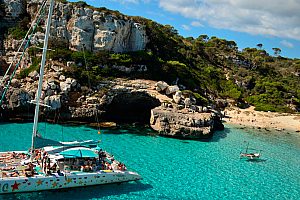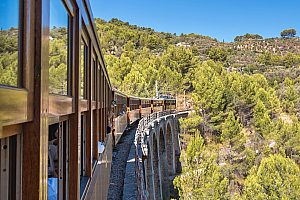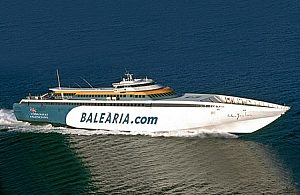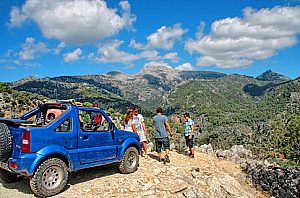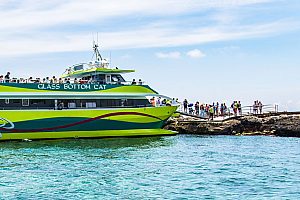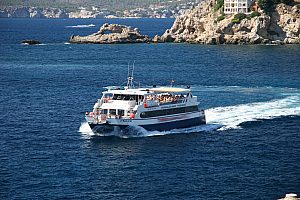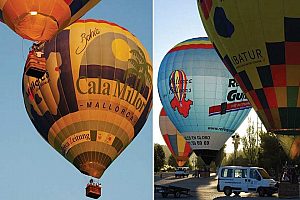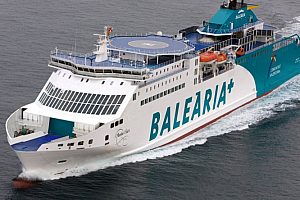Die Klöster- und Weinberge der Inselmitte

Island Centre with monasteries and vineyards
In the centre of Mallorca, south of the Sierra de Tramuntana mountain range and north of the Sierra de Levant, there is a large, vastly flat and extremely fertile plain that has been the centre of agriculture for centuries. The Pla de Mallorca, also known as "Es Pla", which translates simply as "The Plain", offers not only the mildest climate on the island, but also the warmest summer days. Well protected amidst the mountains, most of the rain already falls on the coast before the clouds move on here, which makes winter especially pleasant. The falling rain comes into the valley via torrents and irrigates the many fields and groves.
From the centre of Mallorca rises the Puig de Randa. On this table mountain, also known as the "Holy Mountain", there are three wonderful monasteries, from bottom to top the "Nostra Senyora de Gracia", which lies on a small overhang and whose church can be visited. Also to be visited is the church of the hermitage "Son Honorato". On the top is the monastery of "Nostra Senyora de Cura" with a church, a historical fountain and the beer garden with perhaps the most beautiful view in Mallorca.
Enchanting views in fairytale-like blossom dreams are offered by the centre of Mallorca during the almond blossom season. No matter from which vantage point, these islands of delicate pink will dominate the field of vision everywhere shortly after the start of the year. In January and February, you can take walks through the valleys of the centre of the island and wander through the sea of fragrance and colour.
Besides the almond blossom, don't forget the apricots, especially around Porreres. In the apricot stronghold of the island, many restaurants have specialised in the fruit to conjure up new delicacies in all imaginative variations. This leads to various jams, fresh fruit tarts and pickled apricots, to sweet chocolate-covered fruits and many local dishes to which apricots have been added as a delicious garnish. Agromart, the island-wide shopping chain that sells many fresh and local foods, was founded here in Porreres. Likewise, this small town is the hub of many cycling excursions.
In general, the centre of the island is like a colourful circle of beautiful villages. Not far from Porreres, Montuiri is perched on a hill. Like a defiant castle, the village seems to shield itself from the plain. A special experience once you have climbed the steps leading up to the centre. Many of the villages in the centre of Mallorca are attractive destinations in July and August, when village festivals are celebrated, with a stage featuring live music and local shows taking centre stage in the cosy market squares. Many market stalls, small attractions and oodles of delicacies fill the frame of these festivals.
The most important places to visit in "Es Pla" have to be Sineu, with one of the most famous markets on the whole island, and the former centre of Mallorcan shoe fashion: Alaro. At the height of the industry, shoes were made in over 30 factories, and to this day one manufacturer remains that is definitely a household name to connoisseurs of good cowboy boots: Tony Mora. Today, this romantic town on the slopes of the Sierrade Tramuntana is dominated by the property trade and is inhabited by many international residents.
Don't miss the "good Thursday", Dijous Bo in Inca in November: this is one of the biggest autumn festivals island-wide and there you can find out about clothing, textiles, leather, the latest fashion, culinary delicacies and join in the island's typical nightlife with a full-bodied wine. While Inca offers a lot of handicraft, which is due to the traditional leather and wood processing, the hustle and bustle in Sineu offers you many of the Mallorcan delicacies such as ham and wines.
Mallorca island centre - 4 highlights

Tip 1: Finca holidays

Tip 2: Puig de Randa

Tip 3: Natura Parc Santa Eugenia

Tip 4: Farmers market in Sineu
The middle of the island - Mallorca's wine cellar
Wine growing is all around us in the centre of Mallorca. Whether as extensive fields interrupting the otherwise so dominant and especially in blossom picturesquely enchanting almond groves, or as an export hit. The famous wine route from Santa Maria, via Santa Eugenia, Sencelles, Binissalem with its entertaining wine festival, to Consell is the occasion for many wine tasting tours, wine fairs or the combination of wine & tapas.
The best-known wineries, known locally as "bodegas", are Macia Batle, Jose L Ferrer and Antonio Nadal, the latter named after the most successful tennis coach and mentor of Rafael Nadal, two world-famous Mallorcans. Very popular for wine tasting, the "cata de vinos" or "wine tasting", is a combination of tapas & wine: get to know the culinary heart of Spain while tasting typical regionally prepared tapas with a matching Mallorcan wine. The designation D.O. (Denominación de origen), you can recognise high-quality island wines. This is a designation of origin for Mallorcan wine-growing areas.

From bodega to bodega
Mallorca's bodegas are steeped in tradition and many are highly regarded around the world. Some of the most famous are definitely worth a visit:
1. Bodega Àngel: Founded in the 1960s by a Mallorcan, the winery consists of 17 hectares of land that produces varieties such as Prensal Blanc (Moll), Manto Negro, Chardonnay, Merlot and Cabernet Sauvignon in an ideal location. Viognier is also grown, the result of which is the absolutely recommendable "Angel Viognier". If you visit this bodega, it is actually obligatory not to taste it!
2. Bodega Macia Batle: Jedem interessierten Weinkenner ist dieser Name geläufig. Diese Bodega ist zählt zu einer der ertragreichsten und bekanntesten Bodega auf Mallorca. Und das nicht nur wegen den exzellenten Weinen, wie Manto Negro, Syrah, Cabernet Sauvignon und Merlot, sondern auch wegen den von namhaften Künstlern gestalteten Etiketten (z.B. Gilbert & George). Damit werden die Flaschen zu beliebten Sammelobjekten. Außer sonntags (Markttag in Santa Maria) kann man auf der Bodega auch an Weinführungen teilnehmen. Im Preis inklusive sind neben der Tour auch die Verkostung von 4 Weinen (Empfehlung: Cuvée „Reserve“ aus Manto Negro) sowie einige Naschereien.
3. Bodega Jose L. Ferrer: On 135 hectares of cultivated land, many different types of wine are grown on this largest vineyard on Mallorca. As a pioneer of modern winegrowing on Mallorca, this company is already being run by the 4th generation. On site, visitors can taste the delicious wines for a few euros and also have the corresponding bottles sent directly to their home country, if they are still in stock. If you make a detour here, don't miss the cuvée "Veritas Añada" from 60% Manto Negro, 22% Tempranillo, 9% Cabernet Sauvignon, and 9% Callet, which has already won several international awards.
4. Bodega Miquel Oliver: built in 1865, the winery now produces innovative wines using modern and ancestral winemaking techniques. Be sure to visit this cellar, as it is the best preserved of its age in Mallorca! Miquel Oliver's wines also receive top marks in national and international wine competitions.
5. Bodega Sebastia Pastor: Built from a small vaulted cellar where the small bodega used to only offer table wine and still modestly celebrated the annual harvest, this winery has rapidly developed over the generations as an innovative business. With the introduction of temperature-controlled stainless steel barrels, it was possible to produce an incredibly good, consistent quality at the time. The grape varieties grown, on the other hand, remained conservative: Mallorcan Manto Negro has been growing in the fields around Santa Maria for 45 years, alongside Callet and Premsal-Blanc. Recently, Syrah was also allowed to make its debut. However, the single-varietal Manto Negro, which is only produced from the best vines, gets a recommendation.

Besides delicious wine tastings, hiking and cycling tours are among the most popular activities in the less touristy island area. However, cultural sightseeing tours in particular are becoming increasingly popular. Guests visit towns such as Montuiri, with its beautiful location on the mountainside as well as historical excavations from the Bronze Age and cave dwellings, or Sant Joian with the open-air museum "Els Calderers". So if you are looking for a quiet, in many places almost meditatively relaxing journey through the culture of the Balearic island, the centre of Mallorca is the best destination. With cycling and walking tours through the lush fields and groves, past secluded fincas with yoga retreats or stopping off at the area's cool wine cellars, you'll be well catered for, especially with a guide and his tales. Enjoy a sunny day in the granary of the Balearics and sample the many delicacies of the Spanish.
Recommended excursion tips to discover the centre of Mallorca
- 1. Wine Route Mallorca Route Rich soils in the area around Binissalem have made the centre of the island the most important wine-growing region. The lush green of the vines sometimes stretches as far as the eye can see, making you want to drink a glass of the sun-kissed Mallorcan Vino Tinto. As a wine lover, you should definitely take a tour along the wine route through the towns of Santa María, Santa Eugenia, Sencelles, Binissalem and Consell. Make a stop at each of the bodegas and sample the wide range of wines on offer. The tour is particularly worthwhile in autumn, when the locals in Binissalem organise a big wine festival during the grape harvest in September. If you want to experience a very special highlight, a ride on the Mallorca Wine Express is a good idea. On this gourmet tour, you will stop at the most beautiful places and also enjoy a typical island snack including wine tasting..
- 2. Windmills of Sa Pobla Everybody knows them and they can be seen everywhere - the Mallorcan windmills are one of the landmarks of the Mediterranean island. They are still present today, especially in the agricultural areas of Mallorca, and have been used since the middle of the 19th century to irrigate and drain marshy areas. Today, they are rarely actually used, but there are now programmes working to preserve this cultural asset. When visiting the area around Sa Pobla, it is definitely worth keeping your eyes open for one of the 310 or so windmills and watermills there, because at least as a photo motif they still serve a purpose today. For holidaymakers from the north, there is also an excursion to Sa Pobla.
- 3. Country house Es Calderers More than 700 years ago, the country house Es Calderers was first mentioned in a document - a visit to this great country museum will take you far back in history. Back then, the Mallorcans in the centre of the island lived off what land and livestock they could. And almost everything they needed to live was produced by themselves. Traces of this can be found in Es Calderers in Sant Joan 0, 07240. In addition to the living quarters in the main building, including the dining room with gallant table and the servants' rooms, visitors can see the stables and outbuildings where the black Mallorcan pig is still kept today. There are also workshops, a laundry, a bakery, a smithy and a small chapel. Good value family ticket.
- 4. Horse riding in the centre of the island If you like active holidays, the centre of Mallorca has a few surprise routes. Whether you venture through the vineyards by bike, climb Puig de Randa on a hike, or ride through the beautiful Randa valley on a horseback ride in the centre of the island.

Stories from the center of the island - Glass blowing La Gordiola

Ancient craft of glass art
Exploring special arts
Bestsellers Mallorca
Maybe you are interested in the following activities and tours:

